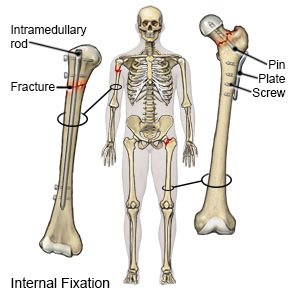ORIF of a Leg Fracture in Children
Medically reviewed by Drugs.com. Last updated on Aug 4, 2025.
Open reduction and internal fixation (ORIF) is surgery to repair your child's broken leg. Open reduction means the bones will be moved back into the correct position. Internal fixation means hardware (such as rods or pins) is used to hold the broken bones together while they heal.
 |
DISCHARGE INSTRUCTIONS:
Call your local emergency number (911 in the US) if:
- Your child has sudden trouble breathing.
Seek care immediately if:
- Your child's toes look pale or blue and feel cold, numb, or tingly.
- Blood soaks through your child's splint or cast.
Call your child's doctor or surgeon if:
- Your child's cast breaks.
- Your child has a fever.
- Your child has chills, a cough, or feels weak and achy.
- Your child is irritable and cries more than usual.
- Your child says his splint or cast feels tighter and you think his toes are more swollen.
- You notice a bad smell coming from your child's splint or cast.
- You have any questions or concerns about your child's condition or care.
Medicines:
- Prescription pain medicine may be given. Ask your child's healthcare provider how to give this medicine safely. Some prescription pain medicines contain acetaminophen. Do not give other medicines that contain acetaminophen without talking to a healthcare provider. Too much acetaminophen may cause liver damage. Prescription pain medicine may cause constipation. Ask your child's healthcare provider how to prevent or treat constipation.
- Do not give aspirin to children younger than 18 years. Your child could develop Reye syndrome if he or she has the flu or a fever and takes aspirin. Reye syndrome can cause life-threatening brain and liver damage. Check your child's medicine labels for aspirin or salicylates.
- Give your child's medicine as directed. Contact your child's healthcare provider if you think the medicine is not working as expected. Tell the provider if your child is allergic to any medicine. Keep a current list of the medicines, vitamins, and herbs your child takes. Include the amounts, and when, how, and why they are taken. Bring the list or the medicines in their containers to follow-up visits. Carry your child's medicine list with you in case of an emergency.
Cast care:
- Check the skin around the cast, splint, or brace every day. You may put lotion on any red or sore areas.
- Do not let your child push down or lean on any part of the cast, splint, or brace. It may break.
- Do not let your child scratch the skin under the cast, splint, or brace by putting a sharp or pointed object down it.
- If your child has a plaster cast, do not let it get wet. Cover the cast with a plastic bag that is taped closed at the top when he or she bathes.
- Have your child move his or her toes several times a day. This will decrease swelling and stiffness.
Take your child to physical therapy if directed:
A physical therapist can teach your child exercises to help improve movement and strength and to decrease pain.
Follow up with your child's doctor or surgeon as directed:
Your child may need to return to have his or her stitches or cast removed. Write down your questions so you remember to ask them during your visits.
© Copyright Merative 2025 Information is for End User's use only and may not be sold, redistributed or otherwise used for commercial purposes.
The above information is an educational aid only. It is not intended as medical advice for individual conditions or treatments. Talk to your doctor, nurse or pharmacist before following any medical regimen to see if it is safe and effective for you.
Further information
Always consult your healthcare provider to ensure the information displayed on this page applies to your personal circumstances.
